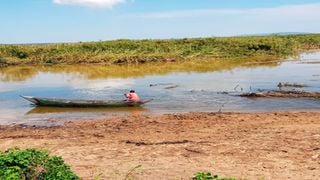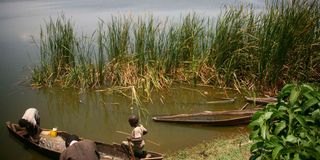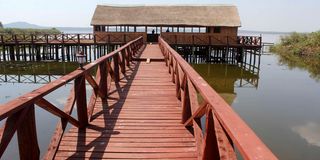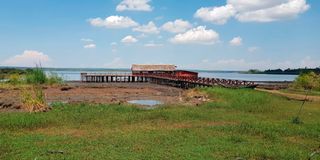
May 2023: Lake Kanyaboli is the second largest oxbow lake in Africa formed after River Yala disconnected from its course at the meander stage, leaving behind a U-shaped lake. The lake is found in Siaya County in western Kenya and is home to a variety of fish species that have almost disappeared from Lake Victoria, the country's largest freshwater lake. The water has receded.
| Mike Owuor | Nation Media GroupSiaya
Premium
A people’s agony after ‘migration’ of their lake
“Nam dar! (the lake is migrating),” the caller told me with a profound sense of urgency. When I prompted him to repeat what he was saying, his agitation peaked.
“Awachoga ni nam dar, jayadha (I am saying the lake is migrating, my friend),” he repeated in the unmistakable dense Alego dialect of Dholuo that is often the subject of much ridicule by those from elsewhere in the Nyanza region, who claim to speak the standard language.
Nam dar was a peculiar turn of phrase and it took a considerable pause for me to register what my village mate from Hawinga in Siaya County actually meant as he breathlessly asked for media coverage to “stop this disaster”.
As a son of the soil who had lived around the lake, and as a sceptical journalist, what he was saying defied reality. How could our jewel in the crown, our beloved Lake Kanyaboli, simply pack up and leave — if the expression was to be taken literally.
Isn’t this the playground of our childhood, the one that embraced us gently as we learnt the first unsteady swimming strokes and unwieldy acrobatics while covered in nothing but nakedness? Isn’t this the one that would patiently watch as we explored our pubescent curiosities knowing that our secrets were safe? Isn’t this the one whose vast generosity provides the tastiest and rarest fish, quenches thirst for human and beast, unwearyingly absorbs dirt from the washing on the shores and still has the sufficiency to proffer water to farmers irrigating their crops nearby?
On her immense back, she carries the numerous legendary floating islands intricately crafted with papyrus and other vegetation that provide a sanctuary for snakes, monkeys, birds, insects and sitatunga (a rare amphibious antelope) straying from the nearby swamp, the occasional leopard and an array of large and small creatures.
These were previously targeted by traditional hunters — an impressive lot with unmatched tracking skills alongside their agile dogs bearing cliché names like Simba and Nyayo — but their adventures have since been curtailed.
In recent years, the lake has become a magnet for the rich and famous who have ringed it with upscale resorts and ornate mansions complete with speedboats, jet skis and other accessories of extravagance.
But sometimes, in almost otherworldly anger, the lake whips up massive waves and summons howling winds. Occasionally, she swallows into her ample belly an adventurous swimmer or fisherman — forcing some to resort to shoreline rituals to retrieve the body of the victim.

May 2023: Lake Kanyaboli is the second largest oxbow lake in Africa formed after River Yala disconnected from its course at the meander stage, leaving behind a U-shaped lake. The lake is found in Siaya County in western Kenya and is home to a variety of fish species that have almost disappeared from Lake Victoria, the country's largest freshwater lake. The water has receded.
The more superstitious whisper of resident spirits that are not to be trifled with, but the religiously inclined talk of the vast waters as a virtue of God’s greatness and a priceless gift. And to conservationists and nature lovers, the lake and its environs are nirvana.
In calm or temperamental times, this has always remained our beautiful lake, watched over from horizon to horizon by the iconic and culturally significant hills — Got Akara and Got Ramogi — and dotted with papyrus-ringed shores, each with a locally relatable identity, that are doorways to the vast waters.
To everyone else, Lake Kanyaboli is Africa’s second-largest oxbow lake — part of the vast Yala Swamp ecosystem that covers 175 square kilometres — with a rich and delicate biodiversity. To others like the erstwhile Dominion Farms and its successor Lake Agro Limited, this is the lifeline for mega commercial farming in the swamp that spawns millions of shillings.
But to the community that surrounds Lake Kanyaboli from shore to shore — in Hawinga, Misori, Gangu, Kanyaboli and Kadenge — this is a source of life and livelihood; a revered landmark as old as time that has nurtured generations by supporting an intricate social and economic ecosystem. Besides, it is a repository of myths, folklore and all shades of beliefs.
The lake has always been a source of identity and pride. Whenever I brag to those willing to listen about “our lake” and they ask if I am talking about Lake Victoria, I take mock offence and dramatically roll my eyes before launching into an encyclopaedic narration of the great Kanyaboli.
More importantly, Kanyaboli is considered an animate being with eternal life. That is why in the rich catalogue of the lake’s lexicon and culture, nam dar is an unthinkableexpression. But on the afternoon of May 11, the unthinkable happened.
The accounts of witnesses, who watched aghast, paint an apocalyptic picture of a usually serene lake suddenly acquiring the ferocity of a river flowing downstream. Nobody knows the exact time — some say it was 3pm others think it was 4pm — but what they all agree on is that on that day, the lake broke a dyke made up of soil and huge volumes of water started rushing out ferociously.

In 2011, the lake was filled with water and boys could fish.
Massive floating papyrus islands were violently tossed like playthings with herculean heft and then sucked into the vortex of whooshing water.
Monkeys shrieked and acrobatically hung on the papyrus and reeds for dear life, birds flew off in bewilderment as water bounced off their fine feathers, snakes could not slither away fast enough and bigger animals stood no chance of a sprint to safety.
Mud fish and catfish
As for the fish — including monye or kamongo (lung fish), fulu (haplochromine), ong’ala (mud fish and catfish), dwela and ngege (tilapia) — their evolutionary swimming adaptation counted for nothing as the strong tide swept them along and off the lake to strange surroundings in the nearby swamp.
Things were no better for the fisher folk. Some wooden boats were ripped apart or crumbled like biscuits, others went belly up while many were haphazardly propelled to awkward resting postures on the now muddy beaches. The fishing nets, set up meticulously for the catch of the day, were ripped by the impact of the water.
Water pipes inside the lake, including those that supplied institutions like the nearby Hawinga Girls Secondary School, were violently dislocated.
This ferocious force of nature went on for three days as people gathered at the scene next to the broken dyke and impotently watched the unfolding spectacle — shouting, gesticulating, whistling, muttering, commentating or mute.
Some fish, thrown out of their natural habitat and deposited on beaches drained of water, writhed in desperate attempts to stay alive. They were picked up by the bucketful as some villagers made the best out of adversity.
For almost a week, after the initial intense three days, the water continued to steadily flow from Lake Kanyaboli.
In this interconnected Yala Swamp ecosystem, the water rushed into farms in the neighbouring Busia County.
It went past nearby smaller water bodies — Lake Sare and Lake Namboyo — and caused a humanitarian disaster, flooding farms, homesteads and schools in the Bunyala area of Budalang’i with villages like Mabinju, Budala, Rukala, Runyu, Iyanga, Bulwani, Buongo and Bumacheke marooned. It was the perfect example of the effects of environmental disasters far away from the epicentre.
When I arrived at the lake a week later, it felt like visiting a loved one in intensive care: stoically gasping for breath, drained of vitality and vying to remain buoyed physically and mentally. There was a feeling of emptiness in the pit of the stomach — but hope lingered.
The shores that just a few days earlier were the source of life for humans and animals were completely drained of water and transformed into a muddy mess, with the top layer of sand washed away. In some places next to the shoreline, the lakebed was already dry, with patterned cracks formed on the crusty sand that seemed to pass an ominous message.
It was apparent this was an instant disaster that threatened the very existence of communities around the lake. To access clean water for domestic use and for their cattle, they had to risk trudging through the mud. Some got stuck during these endeavours, started to slowly sink and had to be extracted in hasty rescue missions.
A short distance away stood a monument to the force of nature. A giant metal tank that had previously defied waves and storms — the relic of an ill-fated agricultural adventure from years gone by — had been unanchored from its resting place and heaved, as though by an enormous crane, to a muddy shore where scrap metal dealers would days later fiercely attack it in pursuit of rusty treasure. On a different beach, a swanky resort mounted on sturdy timber stilts and which had loomed majestically above the water, stood forlornly on the parched lakebed. Without the water around it, it looked out of place and had become an eyesore.
Protective shells
The surreal scene was punctuated by dozens of tortoises on nonchalant walkabouts on the shoreline, occasionally disappearing into their protective shells. Nobody imagined the shores were inhabited by so many tortoises and their remarkable numbers distinguished them as the ultimate survivors.
The middle of the expansive lake still had some water, but it was just about waist-high. Less than 72 hours before disaster struck, a one-storey building could disappear into the water without a trace.
The sheer volume of water lost was unbelievable. If I were a poet composing an ode to Kanyaboli, I would submit that what was left of the nearly 4,000-acre lake was “vast nothingness”.

Better days: An establishment that was under construction on Lake Kanyaboli in Siaya County in 2016.
My uncle, David Odenyo, told me he had never seen or heard about anything like this. He is almost 70 years old. He said the water level has been almost constant over the years except in 1971 when it dropped significantly due to a debilitating drought, and more recently, it rose slightly higher than usual a number of times. I couldn’t find any elder who had witnessed anything like this.
I had heard of lakes that disappeared, but these mostly went through a gradual and painful death, with evident drop in water level before drying up. Global warming and human activity are often to blame. The most recent in the news has been Lake Olbolosat in Nyandarua County that slowly dried up as the community watched helplessly. Nothing like the sudden burst of energy that caused the Lake Kanyaboli disaster.
As I stood where Lake Kanyaboli had broken the dyke, groups of people were huddled together, mostly speaking in low tones but occasionally a voice would be raised to make a collegial point, initiating a commune of views.
The crowd had thinned after the first three days of the water rush, but there was still a considerable number of people making a grim pilgrimage to watch in disbelief what remained of their lake. This was also the perfect setting for “roadside radio” — people narrowcasting a spicy blend of rumour and reality — as the water below continued to serenely flow out.
The dominant themes were what caused this dramatic environmental event, the fate of our beloved lake and the nonchalant response from the authorities and politicians who appeared to have abandoned the people in their hour of need.
Was human activity over the years, including large-scale commercial farming in Yala Swamp, responsible? Was there an element of climate change? Was it the workmanship of the dyke? Had the water level risen too fast? Or was this a punishment from supernatural beings unleashing their full force, as some superstitious residents speculated? Maybe it was a combination of things pent up over time — invisible or ignored until it was too late.
Watched pensively
The following day at the same spot, I watched pensively as lorries took turns to offload enormous rocks and soil as earthmovers spread the piles to slowly rebuild the breached dyke. From across the cavity, the massive machines looked like toys against the landscape.
Some fishermen navigated the shallow waters in their colourful wooden boats. There wasn’t much fish left and setting up the nets was an arduous task, not the routine they had expertly performed for years with deftness handed down over generations. I was told that mud fish and catfish, burrowed beyond the raging waters during the worst of the disaster, were perhaps the only remaining ones to catch.
One fisherman, John Odhiambo, was ashore and did not bother to venture into the water. He stood ramrod straight, staring at what remained of the lake as though in a trance. Previously on a good day, he would make an average of Sh5,000 from the overnight catch, alongside tens of other fisher folk that were the lynchpin of the community’s economy. Would those bountiful days ever return? Now in his late 40s, he didn’t have any other skills and knew no other occupation since he became a fisherman as a teenager. What would he do with his life if things remained the same?
Such existential questions were a conversation starter as the possibility that the lake could be completely drained dawned on the community. In this largely semi-arid area, it is no exaggeration that Lake Kanyaboli makes the difference between flourishing and floundering.
The metaphors were jarring: we have been bequeathed poverty and hunger; the lake has shrunk into a pond; our lake has abandoned us. One quipped that at the rate water was being lost, people would soon start fighting over subdividing land on the dry lakebed. These were obviously more expressive when said in Dholuo.
While the presence of the government was felt when the lake was thriving — in the fisheries inspectors ensuring the right nets were being used, the Kenya Wildlife Service rangers protecting endangered species after a disputed attempt to gazette the area as a national reserve, the water agencies staff with quality checks, among others — the overall impression I got from residents was that the ministries that cover Environment, Wildlife, Water, Fisheries and the county government have been conspicuous in their silence and lacklustre response to save the lake during and after the disaster.
Ababu Namwamba
To be fair, Youth and Sports Cabinet Secretary Ababu Namwamba (who comes from nearby Budalang’i), Siaya Governor James Orengo, Deputy Governor William Oduol (whose home is next to the lake), Busia Governor Paul Otuoma and Alego-Usonga MP Samuel Atandi have visited the site.
But efforts to save the lake are seen to be painfully slow and discordant. Debate on how long the local leaders took to make an appearance and give reassurances to the community also remains robustly divisive.
As I write this personal reflection almost a month later, the water level remains dangerously low but there is lingering hope that something will be done to ensure the inlets will eventually bring in enough water to save the lake after the dyke was repaired. This is not straightforward though.

May 2023: The establishment is now a shadow of what it once was.
Experts often refer to Kanyaboli as a “freshwater deltaic wetland” that was for a long time intricately fed by the backflow of water from Lake Victoria and floodwaters from River Yala and River Nzoia. This natural flow into the lake has over the years been interfered with at various stages during the reclamation of the swamp for farming.
I guess the overarching question remains: will Lake Kanyaboli ever be the same again?
On November 20, 1980, the freshwater Lake Peigneur in the American state of Louisiana dramatically drained into a sink hole in an unusual event caused by nearby drilling. When water eventually started coming back into the lakebed, it was salty after the flow was reversed and affected by a salt mine in the area. The disaster transformed it from a freshwater lake to a brackish water body and also changed the surrounding environment.
Perhaps nothing as drastic is likely to happen to the “new” Lake Kanyaboli if restoration is successful. But after the disruption of the delicate ecosystem, there are real fears about the quality of the water, the fish species that will make it back and the fate of the precious papyrus floating islands.
For now, a community struggling to cope with life around a depleted lake is waiting for a messianic moment. And they fear they could be forgotten after the initial media coverage of the disaster and photo opportunities by the high-profile visitors.
“Bwana gini otiekowa, ng’ama dikonywa?” (This disaster has finished us; who will save us?) my village mate asked in a subsequent no-less-dramatic phone call.
I did not have answers but for my subsequent article I hope to speak to various experts, officials and elders with indigenous knowledge on reviving and sustaining the lake.





